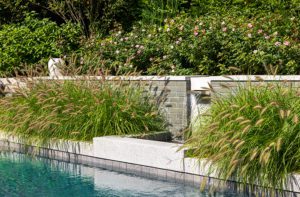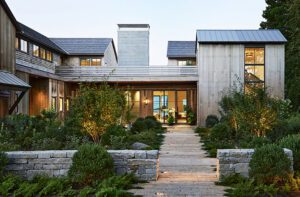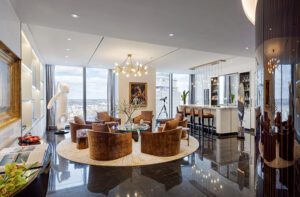A Lake Sunapee Lodge that Mixes Old and New
February 17, 2021
A Lake Sunapee lodge continues its 100-year tradition as a recreational paradise.
Text by Regina Cole Photography by Jim Westphalen


When it comes to houses with sleek new elements that rub elbows with picturesque old elements, Kate Maloney knows how to make the seemingly disparate characteristics fast friends. “Put something modern, like a great light fixture, in the old spaces, while using antiques in the new rooms,” divulges the interior designer.
That’s just what happened at a venerable log cabin on New Hampshire’s Lake Sunapee. Henry Bowles, a U.S. congressman from Massachusetts, built the cabin at the beginning of the twentieth century as a hunting and fishing lodge, says architect Charles Myer. After Bowles died in 1932, his widow, Edna, lived there until she passed away in 1981 at age 97. The current owners, who purchased the home in 2016, are only its third.
The house’s name, given to it by Bowles and inscribed on granite gateposts, is “Natleh,” which means “of nature” in the language of the region’s indigenous people. The original part of the structure, constructed of white cedar and sheathed with peeled birch sourced from the surrounding woods, boasts historic elements like deep roof brackets, fieldstone foundation and fireplace walls, a sweeping covered porch, built-in inglenooks, and screened sleeping porches. Myer designed a two-story addition that replaced a one-story section added by Edna Bowles in the 1970s. It includes a new kitchen and garage as well as new dining, bunk, game, bath, and guest rooms.
“When we added to it, we did not mess with the original part of the house,” explains Myer. “It was in excellent condition; it had been well built and cared for.” Adds Maloney, “We honored its historic elements while we made no apologies for the new section.”
The historic and new come together in the family room, which was the home’s original dining room. A dark, wood-lined alcove that still displays Henry Bowles’s hunting trophies leads into the bright, open room. A sophisticated tonal wallcovering acts as a background for a few carefully chosen pieces of contemporary furniture, including a round sofa.
The homeowners have worked with Myer and Maloney on five previous properties, including two primary residences, so the architect and interior designer were familiar with their clients’ style preferences. But aesthetics aside, there was one driving question behind the project, says Maloney: how many people can we pack in?
“I love the bunk room because that’s what it’s about,” the homeowner points out. “We can always find room for another person.” In that same vein, Myer redesigned the home’s boathouse to include a small kitchen and additional guest quarters for friends and family who might extend their stay.
But the real sweet spot is the large lakeside porch, furnished with wicker seating and a swing conducive to lazy afternoons spent curled up with a book. The homeowner says the family enjoys entire days outdoors. “The view is the whole show,” says the wife.
As it turns out, they are continuing a tradition that began 100 years ago, as Edna Bowles’s diaries and photos attest. The front lawn has always been used for badminton and ball games. The current family still spends hours boating, water skiing (once called “aquaplaning”), swimming, and playing card games. Kids still jump off the same wide dock. And in a fitting tribute, Edna’s green canoes still rest in the boathouse.
Project Team
Architecture: Charles Myer, Charles R. Myer & Partners
Interior design: Kate Maloney, Kate Maloney Interior Design
Builder: Louise Bonfiglio, McGray & Nichols
Landscape design: Charles R. Myer & Partners
Share
![NEH-Logo_Black[1] NEH-Logo_Black[1]](https://b2915716.smushcdn.com/2915716/wp-content/uploads/2022/08/NEH-Logo_Black1-300x162.jpg?lossy=1&strip=1&webp=1)


















You must be logged in to post a comment.